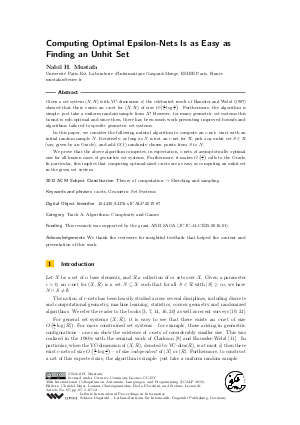Computing Optimal Epsilon-Nets Is as Easy as Finding an Unhit Set
Author Nabil H. Mustafa
-
Part of:
Volume:
46th International Colloquium on Automata, Languages, and Programming (ICALP 2019)
Part of: Series: Leibniz International Proceedings in Informatics (LIPIcs)
Part of: Conference: International Colloquium on Automata, Languages, and Programming (ICALP) - License:
 Creative Commons Attribution 3.0 Unported license
Creative Commons Attribution 3.0 Unported license
- Publication Date: 2019-07-04
File

PDF
LIPIcs.ICALP.2019.87.pdf
- Filesize: 491 kB
- 12 pages
Document Identifiers
Subject Classification
ACM Subject Classification
- Theory of computation → Sketching and sampling
Keywords
- epsilon-nets
- Geometric Set Systems
Metrics
- Access Statistics
-
Total Accesses (updated on a weekly basis)
0Document
0Metadata
Abstract
Given a set system (X, R) with VC-dimension d, the celebrated result of Haussler and Welzl (1987) showed that there exists an epsilon-net for (X, R) of size O(d/epsilon log 1/epsilon). Furthermore, the algorithm is simple: just take a uniform random sample from X! However, for many geometric set systems this bound is sub-optimal and since then, there has been much work presenting improved bounds and algorithms tailored to specific geometric set systems. In this paper, we consider the following natural algorithm to compute an epsilon-net: start with an initial random sample N. Iteratively, as long as N is not an epsilon-net for R, pick any unhit set S in R (say, given by an Oracle), and add O(1) randomly chosen points from S to N. We prove that the above algorithm computes, in expectation, epsilon-nets of asymptotically optimal size for all known cases of geometric set systems. Furthermore, it makes O(1/epsilon) calls to the Oracle. In particular, this implies that computing optimal-sized epsilon-nets are as easy as computing an unhit set in the given set system.
Cite As Get BibTex
Nabil H. Mustafa. Computing Optimal Epsilon-Nets Is as Easy as Finding an Unhit Set. In 46th International Colloquium on Automata, Languages, and Programming (ICALP 2019). Leibniz International Proceedings in Informatics (LIPIcs), Volume 132, pp. 87:1-87:12, Schloss Dagstuhl – Leibniz-Zentrum für Informatik (2019)
https://doi.org/10.4230/LIPIcs.ICALP.2019.87
BibTex
@InProceedings{mustafa:LIPIcs.ICALP.2019.87,
author = {Mustafa, Nabil H.},
title = {{Computing Optimal Epsilon-Nets Is as Easy as Finding an Unhit Set}},
booktitle = {46th International Colloquium on Automata, Languages, and Programming (ICALP 2019)},
pages = {87:1--87:12},
series = {Leibniz International Proceedings in Informatics (LIPIcs)},
ISBN = {978-3-95977-109-2},
ISSN = {1868-8969},
year = {2019},
volume = {132},
editor = {Baier, Christel and Chatzigiannakis, Ioannis and Flocchini, Paola and Leonardi, Stefano},
publisher = {Schloss Dagstuhl -- Leibniz-Zentrum f{\"u}r Informatik},
address = {Dagstuhl, Germany},
URL = {https://drops.dagstuhl.de/entities/document/10.4230/LIPIcs.ICALP.2019.87},
URN = {urn:nbn:de:0030-drops-106632},
doi = {10.4230/LIPIcs.ICALP.2019.87},
annote = {Keywords: epsilon-nets, Geometric Set Systems}
}
Author Details
Funding
This research was supported by the grant ANR SAGA (JCJC-14-CE25-0016-01).
Acknowledgements
We thank the reviewers for insightful feedback that helped the content and presentation of this work.
References
-
P. K. Agarwal. Range Searching. In J. E. Goodman, J. O'Rourke, and C. D. Tóth, editors, Handbook of Discrete and Computational Geometry. CRC Press LLC, 2017.

-
P. K. Agarwal and J. Pan. Near-Linear Algorithms for Geometric Hitting Sets and Set Covers. In Symposium on Computational Geometry, page 271, 2014.

-
N. Alon and J. Spencer. The Probabilistic Method. Wiley-Interscience, third edition, 2008.

-
B. Aronov, E. Ezra, and M. Sharir. Small-size ε-nets for axis-parallel rectangles and boxes. SIAM Journal on Computing, 39(7):3248-3282, 2010.

-
N. Bus, S. Garg, N. H. Mustafa, and S. Ray. Tighter estimates for ε-nets for disks. Computational Geometry: Theory and Applications, 53:27-35, 2016.

-
T. M. Chan, E. Grant, J. Könemann, and M. Sharpe. Weighted Capacitated, Priority, and Geometric Set Cover via Improved Quasi-uniform Sampling. In Proceedings of the 23rd Annual ACM-SIAM Symposium on Discrete Algorithms (SODA), pages 1576-1585, 2012.

-
B. Chazelle. The Discrepancy Method: Randomness and Complexity. Cambridge University Press, 2000.

-
K. L. Clarkson. A Randomized Algorithm for Closest-Point Queries. SIAM J. Comput., 17(4):830-847, 1988.

-
K. L. Clarkson and P. W. Shor. Application of random sampling in computational geometry, II. Discrete & Computational Geometry, 4:387-421, 1989.

-
K. L. Clarkson and K. R. Varadarajan. Improved approximation algorithms for geometric set cover. In Proceedings of the 21st Annual ACM Symposium on Computational Geometry (SoCG), pages 135-141, 2005.

-
D. Haussler and E. Welzl. Epsilon-nets and simplex range queries. Discrete & Computational Geometry, 2:127-151, 1987.

-
J. Komlós, J. Pach, and G. Woeginger. Almost tight bounds for ε-nets. Discrete & Computational Geometry, 7:163-173, 1992.

-
M. Matheny and J. M. Phillips. Practical Low-Dimensional Halfspace Range Space Sampling. In 26th Annual European Symposium on Algorithms (ESA), pages 62:1-62:14, 2018.

-
J. Matoušek. Lectures on Discrete Geometry. Springer, 2002.

-
J. Matoušek. Reporting Points in Halfspaces. Computational Geometry: Theory and Applications, 2(3):169-186, 1992.

-
J. Matoušek. Geometric Discrepancy: An Illustrated Guide. Algorithms and Combinatorics. Springer, 1999.

-
N. H. Mustafa. A Simple Proof of the Shallow Packing Lemma. Discrete & Computational Geometry, 55(3):739-743, 2016.

-
N. H. Mustafa, K. Dutta, and A. Ghosh. A Simple Proof of Optimal Epsilon-nets. Combinatorica, 38(5):1269-1277, 2018.

-
N. H. Mustafa and K. Varadarajan. Epsilon-approximations and Epsilon-nets. In J. E. Goodman, J. O'Rourke, and C. D. Tóth, editors, Handbook of Discrete and Computational Geometry. CRC Press LLC, 2017.

-
J. Pach and P. K. Agarwal. Combinatorial geometry. John Wiley &Sons, 1995.

-
J. Phillips. Coresets and Sketches. In J. E. Goodman, J. O'Rourke, and C. D. Tóth, editors, Handbook of Discrete and Computational Geometry. CRC Press LLC, 2017.

-
E. Pyrga and S. Ray. New existence proofs for ε-nets. In Proceedings of the 24th Annual ACM Symposium on Computational Geometry (SoCG), pages 199-207, 2008.

-
K. R. Varadarajan. Weighted Geometric Set Cover via Quasi-uniform Sampling. In Proceedings of the 42nd Annual ACM Symposium on Theory of Computing (STOC), pages 641-648, 2010.

-
H. Yu, P. K. Agarwal, R. Poreddy, and K. R. Varadarajan. Practical Methods for Shape Fitting and Kinetic Data Structures using Coresets. Algorithmica, 52(3):378-402, 2008.

